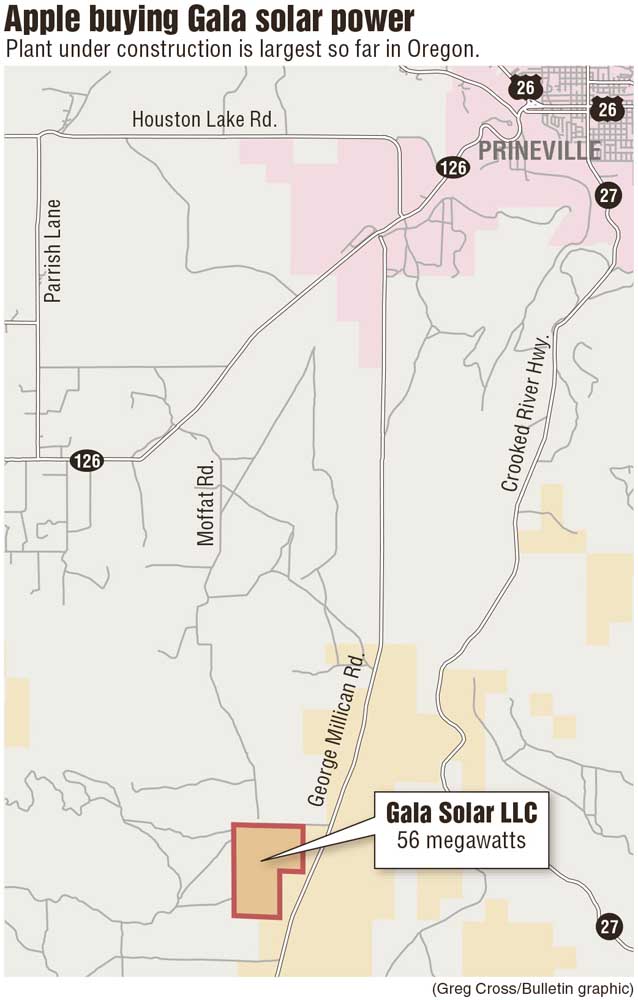Apple drives solar-array construction
Published 5:14 am Friday, April 28, 2017

- Apple drives solar-array construction
Apple is the customer behind a 56-megawatt solar array — the largest so far in Oregon — that is under construction in Crook County, according to Apple’s latest environmental sustainability report.
SunPower Corp., of Richmond, California, announced in February it had broken ground on the Solar Star Oregon II array, also known as the Gala solar project, but at the time the company didn’t name its future customer. A SunPower spokeswoman did not respond to The Bulletin’s request for comment Monday.
The solar plant, which will generate 140 million kilowatt-hours of energy a year, will directly serve Apple’s Prineville data center, according to the report. That will be in addition to power Apple plans to purchase from the 200-megawatt Montague Wind Power Project in Gilliam County, which is set to come online by the end of 2018 and produce 560 million kilowatt-hours per year.
All told, Apple said in the report it signed power-purchase agreements for 700 million kilowatt-hours of energy a year. That’s enough to power 64,742 U.S. homes, according to the U.S. Energy Information Administration’s calculation of average household consumption in 2015.
Apple’s planned power purchases are also much greater than its current use in Prineville, which raises questions about what the company will do with the excess power. The Cupertino, California, computing giant did not respond to The Bulletin’s request for information about its plans for the new energy sources.
In its report, the company said it used 115 million kilowatt-hours of electricity — all from renewable sources — in Prineville last fiscal year, which ended Sept. 30. Across all five U.S. data centers and unspecified colocation facilities, Apple said it consumed 778 million kilowatt-hours of electricity last fiscal year, and 99 percent came from renewable sources.
Apple’s well-guarded Prineville data center consists of two buildings, but the company last year received approval for a third building, which would be 330,000 square feet, plus a logistics building and a power substation.
“I’ll expect to see those going vertical this summer,” Prineville Senior Planner Josh Smith said Monday.
In addition, the company has 210 acres it bought from Crook County for $3.6 million in September 2015. Apple hasn’t submitted a site plan for that property, or discussed when it might be developed, Smith said.
Depending on the terms of the power-purchase agreements, Apple could save money by buying renewable energy in Oregon. In its sustainability report, Apple said it will use Oregon’s Direct Access program, which allows commercial and industrial energy customers to buy directly from power generators, rather than from utility companies.
“To strengthen the connection between Apple and these projects, we use Oregon’s Direct Access program to schedule the renewable energy from these projects directly to our data center,” the report said.
Apple’s use of Direct Access would mean less business for Pacific Power, though the electric utility would still charge Apple for its use of poles and wires, said Mike Dougherty, chief operating officer at the Oregon Public Utility Commission. Utilities may also charge Direct Access customers a “transition charge,” which is supposed to cover the utilities’ capital investments for future capacity and prevent those costs from falling on residential customers.
A proposal before the Oregon Legislature, Senate Bill 979, would have allowed new commercial or industrial customers who opt for Direct Access to skip the transition charges. That bill is effectively stalled, but the PUC staff would like to investigate questions about the impact of waiving those charges, Dougherty said.
Gala is one of five large solar projects, ranging from 34 megawatts to 56 megawatts, that Crook County has permitted since 2015. So far Gala is the only one under construction, and only three other counties in Oregon have similar-scale solar projects in the works, according to a database maintained by the Portland-based Renewable Northwest Project, which advocates for clean energy sources.
Apple could also draw from smaller solar arrays being built around the state. Apple said it signed a long-term purchase agreement with Cypress Creek Renewables to provide back-up energy from a 50-megawatt portfolio of six solar arrays in Oregon. One of Cypress Creek’s projects is off Neff Road, east of Bend in Deschutes County.
— Reporter: 541-617-7860, kmclaughlin@bendbulletin.com






